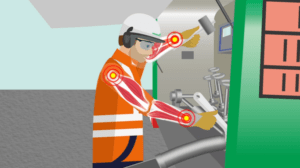SHP hears from Mark Pawsey, UKI Distribution Manager at industrial gas company, Air Products, who explains how and why the business has replaced traditional classroom methods with a more modern approach…
The transient nature of driver populations means that delivering mandatory safety refresher training can be difficult to co-ordinate and administer.

Mark Pawsey, UKI Distribution Manager at Air Products
Let’s be honest. How many of us have sat in front of series of PowerPoint slides, struggling to take in the content? The answer, in truth, is probably all of us. It was this realisation that led the team at Air Products to completely re-think the way we deliver our driver safety refresher training, instead embracing the concept of app-based micro-learning.
As a global business, with over 350 drivers operating in the UK alone, ensuring that our teams are up to date on their training is no mean feat. Qualifications need to be refreshed over a one-to-five-year cycle and this presents a number of challenges – from co-ordinating availability in line with operational demands, to ensuring consistency of message when using third party trainers.
Our traditional approach was to gather our drivers in a classroom environment, either for a full day, or at the end of a shift, presenting them with up to a 4-hour, 60-slide presentation. It became clear however – both from our own research and from driver feedback – that we could be doing something much more effective.
Little and often
Cognitive psychology shows that the human brain struggles to absorb information if it’s delivered in large volume. This is best demonstrated through something called the Ebbinghaus forgetting curve that illustrates how our memory of learned information deteriorates over time. This means that just one month on from a training session, the human brain is likely to only retain a shocking 21% of what it learnt.
The good news, however, is that this pattern or ‘forgetting curve’ can be positively impacted by regular reminders or refreshers, in the form of a micro-learning approach, the premise of which is little and often. It involves breaking down information into topical, bite-sized chunks and delivering this through highly targeted ‘learning bursts’.
Armed with this knowledge, we launched a new app-based micro-learning approach for our drivers, in the form of short, safety refresher animations.
All our drivers have a mobile phone that they use for their daily routine activities, so in many ways, this was simply a continuation of that mobile-based approach. What was new, was that instead of having to complete their safety refresher training in a classroom environment, drivers were now able to access our learning management system via an app on their phone and complete their training remotely.
Animated and interactive
 We knew that to effectively influence behaviours, any training material needed to be short and to the point, relevant, engaging, and accessible. But what does that look like in practice?
We knew that to effectively influence behaviours, any training material needed to be short and to the point, relevant, engaging, and accessible. But what does that look like in practice?
Training videos are animated in style, and a maximum of five minutes in length, with a new module released once a month over a three-year period.
We want to avoid a scenario where our drivers see or hear something that they don’t perceive to be relevant to them, so we adapt the animation to reflect the different types of vehicles that are in use and the appropriate driver uniform. Drivers can also choose the language in which the training refresher is delivered so that they can hear it in their mother tongue.
We also use technology and techniques, such as gamification, to make our materials interactive and engaging. This modern, animated format allows us to simulate and illustrate safe and unsafe conditions, regularly repeat key safety messages and themes, and cover a large amount of material in a short time. Whereas previously refresher training on slips, trips and falls would have been delivered via 33 PowerPoint slides in a one-hour classroom session, now it is delivered by three lots of three-minute animated films.
Supporting implementation and uptake
You’d be forgiven for thinking that there may have been some resistance to an online, app-based approach, particularly among our older drivers however quite the opposite is true.
Feedback from the drivers after the initial pilot was unlike anything we had seen before, in terms of level of both engagement and positivity. 99% of drivers thought the new format would improve their safety, 94% of drivers said they would like to see more training in this format.
More than a year on, our drivers regularly come to us and ask for additional non-mandatory training to be delivered in this new format. We have, for example, just released a new sleep apnoea module, in line with new support we are offering. Equally, our drivers have also asked for app-based training on using their digital tachograph cards to ensure they are compliant with Government regulations.
Of course, remote learning does not mean leaving the drivers to their own devices and hoping for the best. On the contrary, our reporting capability is improved. We are able to show which drivers have viewed a training video and the percentage of the overall video content viewed. We can also demonstrate which drivers have read various training documents and the time they’ve spent doing so.
In addition, every refresher module is accompanied by randomised checkpoint questions, that allow us to check that drivers are absorbing and, critically, understanding the training. The results of these checkpoint questions are automatically uploaded to training records, supporting compliance reporting and allowing our training teams to intervene and offer one to one coaching and support when needed.
We’ve taken practical steps too, to support uptake, ensuring that the app and training works on both 4G and wi-fi and allowing the drivers to access it at whatever time of day suits them best. This has had a really positive impact. We generally find that 90% of drivers complete the latest safety refresher module within two weeks of it being released.
Of course, there remain instances where in-person training is the best solution, and we recognise that. Induction safety training for example must be completed face to face so drivers can see for themselves where facilities and fire muster points are. What this is not, is a one size fits all approach. It is instead about us embracing a flexible, adaptable training method that directly responds to the ways in which our drivers best learn and develop.
Delivering results
 At a practical level, converting the refresher training programme to this new format has achieved a saving in training time of 1,050 days.
At a practical level, converting the refresher training programme to this new format has achieved a saving in training time of 1,050 days.
Ultimately though, all of this is driven by a desire to keep our teams, and other road users, safe. Our goal is zero incidents and accidents – and we can see a direct correlation between the introduction of the micro-learning, app-based approach and progress towards this goal. Slips, trips and falls incidents were, for example, significantly lower in the three-month period immediately following the release of the training module in the new format compared with the same period the year before.
Looking ahead
This new way of learning has already been replicated across Europe, and – importantly, the digital format means that we can visually ensure that the content appeals to each specific geography – changing vehicles shown from left hand to right hand drive, adapting the way uniform is depicted according to country and so on.
What’s next? Well, we’re looking to employ a micro-learning approach to other areas of our business, considering how engineering teams, for example, can learn and train in this way.
This is about taking safety training beyond a ring-fenced day in a classroom and embedding it as part of a day-to day routine so that safety becomes part of our psyche and consciousness in whatever we do. The results speak for themselves.
Gary Norris has been an HGV driver for the last 36 years and has worked at Air Products for the last 7 years. He has found the new training strategy has significantly improved his ability to absorb and retain critical safety information: “I’ve been a driver for a long time and, with safety requirements more stringent than ever before, there’s a lot of information to take in.
App-based learning and the ability to just log in and complete my refresher training when it’s convenient to me is great. You don’t have to do everything in one go – you can complete part of the training and then have a break and come back to it, which makes a big difference. It’s all in bite-sized chunks.
“The short video clips and interactive elements of the app work really well too. I find I can absorb information better and it’s a lot easier to concentrate than being in a classroom environment for hours listening to lots of PowerPoint slides.
“I prefer this way of doing things and I know a lot of other drivers do too.”
The Safety Conversation Podcast: Listen now!
The Safety Conversation with SHP (previously the Safety and Health Podcast) aims to bring you the latest news, insights and legislation updates in the form of interviews, discussions and panel debates from leading figures within the profession.
Find us on Apple Podcasts, Spotify and Google Podcasts, subscribe and join the conversation today!


 We knew that to effectively influence behaviours, any training material needed to be short and to the point, relevant, engaging, and accessible. But what does that look like in practice?
We knew that to effectively influence behaviours, any training material needed to be short and to the point, relevant, engaging, and accessible. But what does that look like in practice? At a practical level, converting the refresher training programme to this new format has achieved a saving in training time of 1,050 days.
At a practical level, converting the refresher training programme to this new format has achieved a saving in training time of 1,050 days.